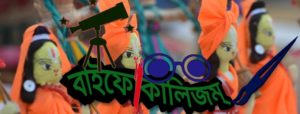অতীতের বাংলা, গৌড় রাজ্যের উত্থান
(Ancient Bengal, rise of the kingdom of Gauda) — লিখছেন – দুর্গাশঙ্কর দীর্ঘাঙ্গী
29
এই স্বাধীন গৌড় রাজ্যের উত্থান সম্ভবত সহজতর করেছিল, মহাসেনগুপ্তের মহাবিপর্যয়। কয়েকজন ঐতিহাসিক পণ্ডিতদের মতে এনার দুর্দশাজনক
হার হয়েছিল কালচুরির কাছে। এই মহাবিপর্যয়ের
ব্যপ্তির পরিমান অনুমান করা যেতে পারে ৫৯৫ সালের(595 A. D.,) ঘটনার দিকে তাকালে। আবার এইসব পণ্ডিতগণ যা বলেছিলেন তাহ’ল
মালভ রাজ্যের পরবর্তী গুপ্ত রাজাদের রাজধানী ছিল উজ্জ্বয়িনীতে। এই রাজধানী কালচুরির রাজা
শঙ্করাগণের অধিকারে ছিল এবং থানেশ্বরের রাজা প্রভাকরবর্ধনের আদালতে মহাসেনগুপ্তের
দুই পুত্রকে থাকতে বাধ্য করা হয়েছিল ।
“This reconstruction of the history of
Mahasenagupta cannot, of course, be regarded as certain, but, if true, it explains
the rise of the independent kingdom of
Gauda-Magadha out of the ruins of the Later Gupta empire. (This view is fully developed by Dr. D. C. Ganguly who even goes so far as to assert that it was the
kalachuri king Buddharaja, son of
Sankaragana (and not Devagupta , as is
generally held), who defeated and killed
Grahavarman, the Maukhari king, and imprisoned his Rajyasri at Kanauj.
These statements are not, however,
Supported by any reliable evidence and are based on the assumption that the Kalachuris were the only rulers of Malava from 595 A. D. to 629 A. D. for which there is no proof.) It also explains why Sasanka
, the founder of the independent kingdom,
was involved in a war with the Maukhari king and the ruler of Kamrupa, the two great enemies of later Guptas, and formed
an alliance with Devagupta, king of Malava.
In other words, the political traditions of the
Sixth century were continued in the seventh century A. D. “
30
রাজা শশাঙ্ক বাংলার ইতিহাসে এক বিশিষ্ট স্থান
অধিকার করেছিলেন। তাঁকে সর্বপ্রথম সার্বভৌম
বাঙালি বলে মনে করা হয়। তিনিই প্রথম রাজা
যিনি বাহুবলে তাঁর এলাকা বিস্তার করেন, যার ফলে ভৌগোলিক সীমানা বেড়ে গেছল।
তিনি কি ভাবে এবং ঠিক কোন বৎসরে গৌড়দেশে
সার্বভৌম রাজ্যের প্রতিষ্ঠা করেছিলেন, সে বিষয়ে
নির্দিষ্ট তথ্য নেই। রোটাসগড়ের প্রাপ্ত শিলালিপি
থেকে “শ্রী মহা সামন্ত শশাঙ্ক”- এই তথ্য পাওয়া গেছে। অর্থাৎ ” প্রশংসনীয় মহান দাতব্য”
ইনিই যদি গৌড় রাজ্যের সেই শশাঙ্ক হন, যেমনটি
সকল পণ্ডিতগণ বলছেন তাহলে বলা যায় এই শশাঙ্ক প্রথম জীবনে সাধারণ শাসক ছিলেন।
” He is also the first known king of Bengal who extended his suzerainty over territories far beyond the geographical
boundary of that province.
Of his early life and the circumstances under which he came to occupy the Thorne
of Gauda we possess no definite information. A seal matrix cut in the rock
of the hill-fort of Rohtasgarh records the
name of “Sri- Mahasamanta Sasanka” i.e.
‘the illustrious great vassal Sasanka’.
” ON THE WORLD HERITAGE DAY We
Should preserve our culture, tradition and History,and it’s an opportunity to emphasise the importance of safeguarding conserving, preserving our heritage. “
‘দেশের কাব্যে, গানে, ছড়ায়, প্রাচীন মন্দিরের ভগ্নাবশেষ, কীটদষ্ট পুঁথির জীর্ণপত্রে, গ্রাম্য পার্বণে, ব্রতকথায়, পল্লীর কৃষি কুটিরে …….. স্বদেশ প্রেমকে সন্ধান করিবার জন্য দিনের পর দিন
বিনা বেতনে, বিনা পুরস্কারে, খ্যাতিবিহীন কর্মে
স্বদেশপ্রেমকে সার্থক করো। ‘
বিশ্বকবি রবীন্দ্রনাথ ঠাকুর।
গৌড়াধিপতি শশাঙ্ক
(Shashanka, the king of Gauda)
31
Sasanka was the first independent king of
Unified Bengal, called Gauda Kingdom. He was a Hindu king and devotee of Lord Shiva. Gauda kingdom during the late classical period of the India subcontinent
Originated in the region of Bengal includes Bangladesh and West Bengal. Capital:
Karnasuvarna, (Sasanka’ s capital city, Karnasuvarna, cannot be identified with absolute certainty, but it is most probably represented today by the ruins at Rangamati, six miles south of Berhampur in the Murshidabad district -The History of Bengal (D.U.) He reigned around 7th Century. According to other Historians, Sasanka ruled approx.between 590-625.
The development of the Bengali Calendar
is often attributed to Sasanka because starting date falls within his reign.
“All that we definitely know is that before
606 A. D. Sasanka became the king of Gauda with his capital at Karnasuvarna which has been identified with Rangamati,
six miles South-west West of Berhampur in the Murshidabad District.
There is hardly any doubt that both Northern and Western Bengal was included in the dominions of Sasanka. On the other hand, Hired Tsang’s reference to prove the existence of Samatata as a seperate independent state in the first half of the seventh century A. D……
Sasanka’ s dominions probably included Magadha from the very
Beginning and he soon felt powerful enough to follow an aggressive foreign policy. He extended his suzerainty as far South as the Chills Lake in Orissa. For,
in a record dated in the year 619 A. D.,
Maharaja Mahasamanta Sri Madhavaraja(ll) the king of the saildbhava
dynasty ruling over Kongo day, invokes the name of Sasanka as the suzerain….
there is no doubt that it comprised the region round the Chika Lake in Orissa, and probably extended South to the Ganjam district. In order to extend his power to the province of Kongoda, Sasanka must have been defeated the Mana chiefs whom we find in possession of the intervening territory in 602 A. D.
We are more fortunate in respect of the campaigns of Sasanka in northern India.
As his chief adversary was the great emperor Harshavardhana, we get some detailed information of him from Banabhatta’s Harsha- Charita and the account of the Chinese Pilgrim Hiuen
Tsang. It seems that the keynote of
Sasanka’ s foreign policy was to secure
his dominions from the aggressive designs
of the Maukhari rulers who had for three
generations carried on a bitter struggle with the Later Guptas for the possession
of Magadha and Gauda… “
ক্রমশঃ…
References:
The History of Bengal-1943
Dr. (Prof.)R .C.Majumdar
ভারতের ইতিহাস কথা -১৯৭৯
ডঃ কিরণচন্দ্র চৌধুরী


























